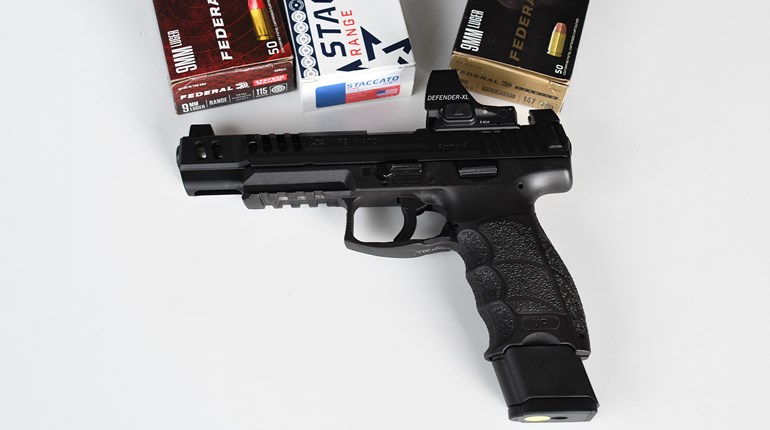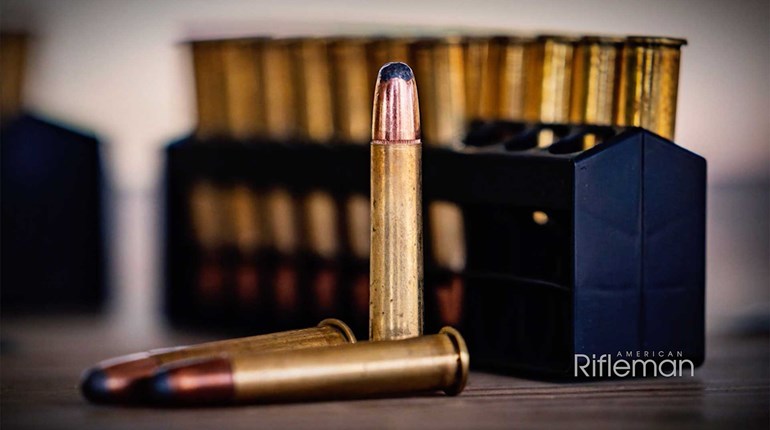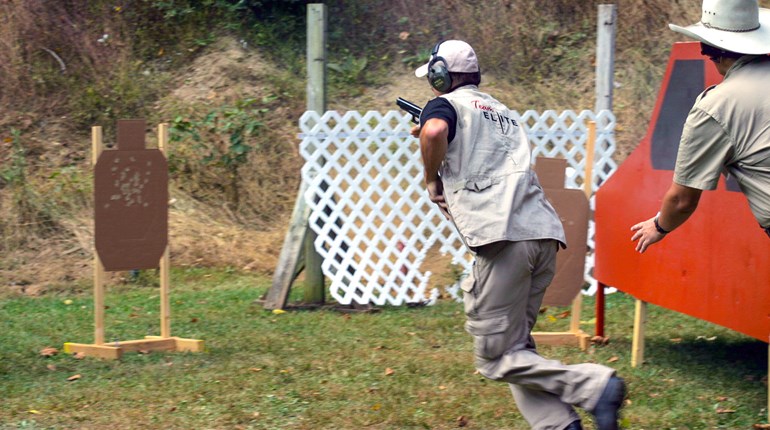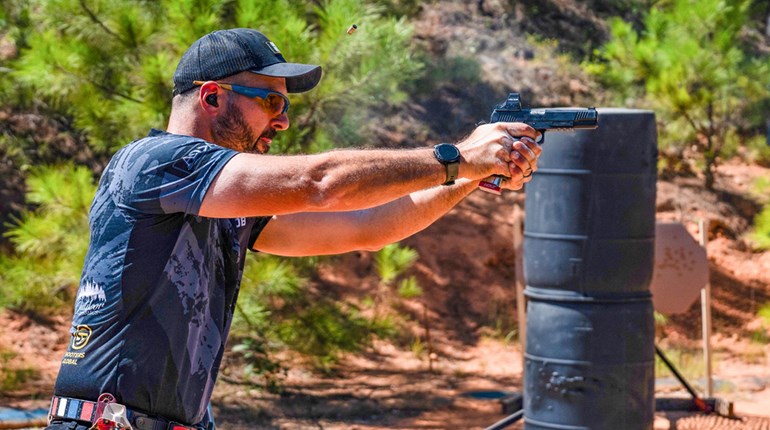
Ruger’s R&D guys have been quite active over the last several years. They have listened to input from both law enforcement and the private sector in the process of developing new guns and modifying older models. To this baseline of civilian and law enforcement suggestions they have added some military requirements gathered from the U.S. Military’s Joint Combat Pistol specifications and, later, the Modular Handgun System Program. The end result is Ruger’s next generation striker-fired polymer-frame pistol called, simply, the Ruger American Pistol. The company’s hope is that the new family of pistols (there will be additional models) will fill the needs of all Americans who exercise their Second Amendment rights.
Fans of the SR-series of pistols will be relieved to know the American will be supplementing, not replacing that line. Ruger Director of Media Relations Ken Jorgensen explains, “The SR-Series is alive and well. ...It is the only way to get a two-tone pistol, the only way to get a Compact and the only way to get a .40 S&W-chambered pistol.”

Let’s start with a look at the American’s polymer frame, one of the two basic ingredients in a modern, full-size, duty/service pistol. Ruger’s frame, and likewise the interchangeable grip modules, are formed from glass-filled nylon, which has greater compressive strength and rigidity compared to other nylons. Strength, per se, was not the concern, but the additional strength allows the frame to be a fraction lighter (no big deal in a full-size service pistol) and thinner (which is a big deal to shooters with small hands or short fingers.) Control of the gun during rapid fire and proper trigger manipulation can be very difficult on modern striker-fired pistols if the grip size and distance-to-trigger is too great for the operator’s hands. I was having a terrible time shooting the Ruger initially with the medium-size grip module installed. A switch to the smallest module brought everything back under control. Almost mandatory for a modern pistol, the Ruger has an integral rail forward of the trigger guard. I say “almost mandatory” because on a pistol not designed for concealed carry there’s no reason not to include an accessory rail, and for a low-light, life-threatening engagement, there is no substitute for a bright light.

The ergonomics of the frame struck me as quite good. Edges are rounded so the gun tends to melt into one’s hand, and there are no finger grooves on the frontstrap forcing you into a grip that may not be correct for your hand. Achieving a non-slip grip is facilitated by a diamond-pattern surface on both frontstrap and backstrap that the Ruger Marketing Department has creatively called Purpose Oriented Texturing. Really? It’s called POT? Anyway, in the 9 mm pistol I received, the diamonds provided plenty of grip control. The base of the backstrap has a short lip extending below the magazine well that aligns with an angled cut in the magazine bases and prevents pinching yourself when slamming in a fresh magazine; a nice, thoughtful touch. The ambidextrous controls cater to southpaws (or an injured citizen still fighting). Both slide-stop lever and magazine-release buttons (shaped like triangles) are on both sides of the gun and easily operated with either hand. The takedown lever is only on the left side of the pistol, but fieldstripping is quite simple and independent of being right or left handed.

The American’s slide and barrel are made of stainless steel. The slide has a matte-black nitride coating that looks cool, reduces glare and resists wear. The ejection port is slightly angled and there is a large claw extractor to ensure the spent case is always pulled from the chamber. The edges, muzzle and rear of the slide have been beveled to assist in presenting and reholstering the pistol. Front and rear sights are Novak’s LoMount three-dot system with both sights dovetail-mounted. The rear sight can be moved for windage adjustments and has a setscrew to lock it in place. The rear of the slide has slightly slanted serrations in a diamond-crosscut pattern to facilitate a good grip without presenting an overly rough surface. There is a notch cut in the top of the barrel that lets you see if the chamber is loaded. It’s fine in daylight, but not so good in dim light, so learn to perform a non-visual chamber check as taught in the various training schools.

“Striker fired” is the other common ingredient in the modern service pistol. This means that except for the trigger, the pistol has no visible components involved in firing the weapon. Instead of an external hammer that instantly reveals whether or not the weapon is cocked, there is an internal striker that provides no indication as to the pistol’s state of readiness. Manufacturers have done a good job upgrading the mechanisms of striker-fired pistols over the years. On earlier designs, cycling the slide partially cocked the internal striker, relying on the initial trigger pull to complete the cocking. In Ruger’s pistol, the striker is fully cocked by the slide cycling, meaning the trigger pull simply has to release the sear. Still, on my test gun, the trigger broke anywhere from 7 to 8 pounds of pressure, and there was some “stacking” at various points along the trigger path. A second pistol, though, had a more agreeable 5-pound, 6-ounce trigger pull.
Three things helped when shooting the American. First, as previously mentioned I switched from the medium grip modules to the smallest set. Now I could get my trigger finger farther into the trigger guard allowing me to apply a more direct, linear pressure on the trigger. Instead of pushing the trigger safety (or inner trigger) into the side wall of the trigger, I was pressing the entire trigger system straight toward the rear of the pistol, or at least in more of a straight line than before. There was still some “stacking,” but that’s not unusual during the break-in period of a weapon. And, in fairness, I had ignored the factory instructions and failed to either clean or lubricate the pistol before taking it to the range. The good news is that there were absolutely no failures of any kind at any time with the new Ruger. Out of the box and into the fray without missing a beat—that’s a good testimonial for a defensive pistol.

The second thing that helped occurred when working the moving targets during a writer’s event. This was a “multiple-shoot” exercise where we tried to put as many shots as possible into the bad guy crossing 15 yards in front of us. We were shooting standing with most of us able to fire anywhere from five to eight shots on each crossing. It was here I experienced the excellent trigger-reset characteristics of the American. The trigger would reset in about half to two-thirds of the return travel distance, and it did so with a click that could be both heard and felt. Participants were shooting from the typical fighting stance, traversing both right and left with the target. Working with moving targets from this position, changes in trigger pull weight were considerably less distracting than when trying to shoot groups from a rest.
Third was the built-in (or molded in) trigger stop inside the trigger guard behind the trigger. When the trigger broke, it immediately hit the stop and…stopped. There was no concentration break trying to recover from a massive overtravel; you simply released pressure and eased the trigger forward to the reset click while tracking the target and pressed again.

Additional features of the American were numerous and desirable. For example, there is a stainless steel Fire Control Insert Assembly that’s basically a self-contained chassis that houses many of the fire-control parts of the pistol. It is this chassis and not the pistol’s polymer frame assembly that contains the pistol’s serial number. The nitride-treated chassis has four sections of stainless steel rails (two on each side of the pistol) each 1.5 inches long on which the steel slide rides. Right from the first shot with no wipe down or application of lubrication, the pistol ran “smooth” and felt like it had been finely polished somewhere in the assembly process. Magazine ejection was extremely positive with empty magazines being thrown clear of the gun regardless of which mag-release button was pushed. During reload, one solid push on the base of the new magazine resulted in solid lockup whether the slide was open or closed; good features on a fighting pistol. Fit and finish were excellent everywhere on the gun.
As is the case with modern pistols utilizing a full-power round like the 9 mm, the American is a recoil-operated, locked-breech semi-auto pistol. My test pistol fires with the magazine removed, a feature I find desirable in the event a reload might be interrupted or fumbled leaving just the one round in the chamber with which to defend yourself. The pistol has a Ruger patent-pending barrel cam that will help dampen/reduce felt recoil. I honestly can’t say I noticed during my evaluation, but might given more time with the pistol, and the opportunity to directly compare it to other like-chambered handguns. On the other hand, the low bore axis of the American did noticeably aid in control of relatively stout +P ammunition.
I’d like more training/practice time with this gun to better acquaint my-self with the trigger system. Admittedly, I’ve never been a big fan of the “trigger-in-a-trigger” system, but I don’t think it would take me long to adapt myself to the roughly 3⁄8 inch of trigger travel. I’ve been through five-day classes using similar striker-fired, polymer-frame pistols, and by the end of each week felt very comfortable with those guns.
In any event, I consider Ruger’s new American a well-designed and built fighting handgun. Hmm, perhaps it’s time to enroll in another pistol class.







































